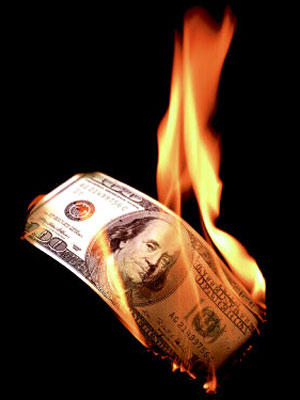 It would be one thing if industrial scale wind turbines significantly reduced CO2 emissions. Few people understand that industrial scale wind turbines can't function without conventional power plants. In our state, that means coal burning. The power plants don't power down when Wisconsin's paltry winds are blowing. There may be more electricity being generated at times by the turbines, but there is no reduction in current CO2 emissions from the power plants. In fact, when the wind isn't blowing hard enough, these giant machines draw more energy than they produce. At a time when money is tight and the environment is in peril, promoting industrial scale wind in a state with a low wind resource is a crime against the environment, the tax payers, and the good name of our state. Will our legislators figure this out in time, or, helped along by wind lobbyists like RENEW, WISCONSIN, will Wisconsin residents be on the sucker end of the latest "green" Ponzie scheme?
It would be one thing if industrial scale wind turbines significantly reduced CO2 emissions. Few people understand that industrial scale wind turbines can't function without conventional power plants. In our state, that means coal burning. The power plants don't power down when Wisconsin's paltry winds are blowing. There may be more electricity being generated at times by the turbines, but there is no reduction in current CO2 emissions from the power plants. In fact, when the wind isn't blowing hard enough, these giant machines draw more energy than they produce. At a time when money is tight and the environment is in peril, promoting industrial scale wind in a state with a low wind resource is a crime against the environment, the tax payers, and the good name of our state. Will our legislators figure this out in time, or, helped along by wind lobbyists like RENEW, WISCONSIN, will Wisconsin residents be on the sucker end of the latest "green" Ponzie scheme?
Ethanol, meet Big Wind.
Here's an article from Milwaukee's Daily Reporter.
Power Push is Premature, Some Argue
(Click here to read at source)
Posted December 2, 2008
As the building industry prepares for a state-fueled run on energy-related construction, the Wisconsin Industrial Energy Group argues the work is unnecessary and too expensive right now.
“The state mandates 10 percent renewable energy by 2015,” said Todd Stuart, executive director of the nonprofit group representing energy consumers. “So that means add new capacity or shut down existing plants. Either way, it’s going to cost you.
“The writing’s on the wall for a 25 percent mandate, and that’s going to dictate the economics of what you build. There’s going to be a huge amount of wind farm construction that’s going to cost billions, and that money’s going to have to come from somewhere.”
He said ratepayers will pay. While power bills might stay down in 2009 because of the struggling economy, the increase is coming, he said.
The problem is that power demand in the state is tapering off, and Wisconsin is positioning itself to have a lot of excess capacity, Stuart said.
“In a time of slow to no growth in terms of demand, we’re adding billions into the rate base,” he said. “Do you need that capacity?”
We Energies spokesman Brian Manthey said the state does.
“We have to look at the late 1990s when the state was facing serious reliability constraints,” he said. “You can’t look at short-term snapshots for long-term strategies. We have to look forward at least 10 years.”
However, in doing so, ratepayers likely will face double-digit increases, Stuart said.
“I see it as a tax,” he said.
But Forrest Ceel, president of the International Brotherhood of Electrical Workers Local 2150 and a member of the Governor’s Task Force on Global Warming, said it likely will cost more if energy producers wait to build the projects.
“I think the state’s renewable portfolio standards are aggressive and somewhat difficult,” he said. “But there is some leeway there in light of economic situations.
“It’s hard to read what the economy will be 10 years out, so who knows? By the time we get to 2017 or 2018, the state might decide it could ease up a little.”
Mark Reihl, executive director of the Wisconsin State Council of Carpenters, said the industry would have a difficult time refusing work, and, given the decline in demand for materials, he argued this is the time to build.
“And I think it’s time to invest in infrastructure,” he said, “on all levels.”
Manthey said it is difficult to estimate how much more power customers will pay in light of new energy development, but he said increases are likely.
“There are costs associated with whatever you do,” he said. “And those costs do enter into rates.”
Stuart said, while proponents of building more generation look at the long-term picture, it’s difficult to ignore the short-term issues.
“We have to make sure we’re doing absolutely the right thing,” he said. “Sure, 10 years from now we may be in a great position, but the folks I talk to right now are living quarter to quarter.
“There are billions of dollars in the pipeline that has to be paid for.”